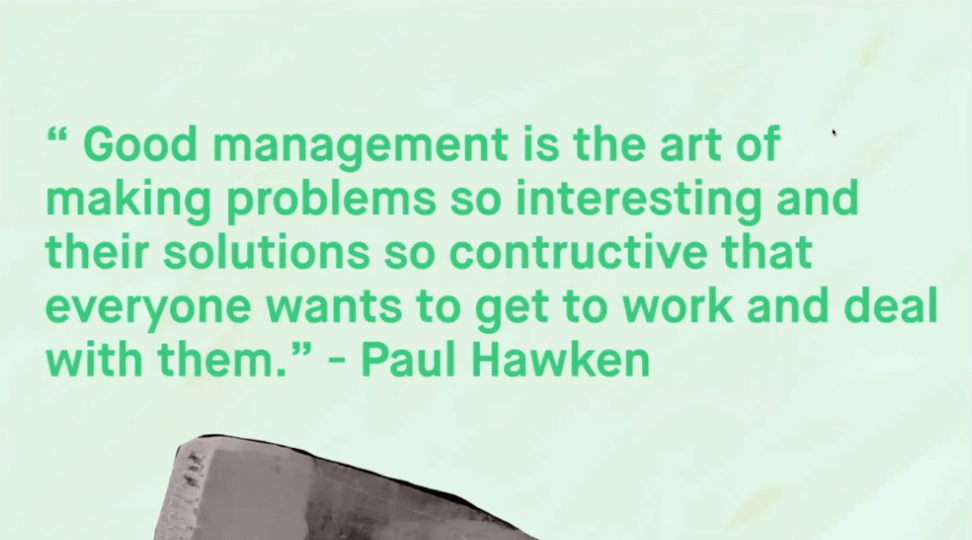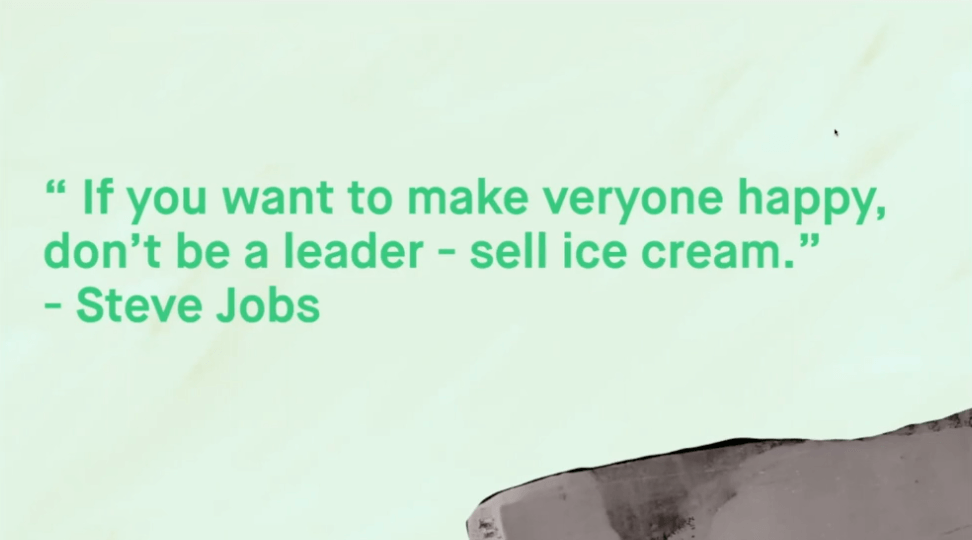Definitions of product management can be vast and varied, even within our own community, and that can make navigating a product management career equally ambiguous and, let’s face it, frustrating.
My name's Mamuna Oladipo, and I'm the Senior Vice President of Product Design and Engineering at Kickstarter. When working on my thoughts for this article, I found myself really thinking about how much I valued my team. To me, the importance of being a strong leader is to have a solid team around them.
Product manager qualities
Navigating a product management career can be equally ambiguous and, at times, frustrating. It's hard to know what qualities you need since the way we define the product role at one organization is likely very different from another.
I think about the number of people I know who get stuck in a senior product manager role, unable to really make the transition to being a leader. In the roles of a PM or associate PM, Product Manager, or Senior Product Manager, you can really keep doing what you've been doing with a deeper level of expertise and execution over time.
But as a product leader, you need to really start flexing that strategic muscle as it pertains to your product organization.
Product manager vs. product leader
To work our way to understanding the anatomy of a strong product leader, we first need to make a quick stop in the foundation of understanding what a product manager is versus a product leader.
Product leader
When I say product leader, I generally define this as being one of these titles:
- Chief Product Officer
- Vice President of Product
- Head of Product
- Director of Product
- Product Team Leader
- Group Product Manager
It's important that if you are in one of these roles, you recognize yourself as a product leader. The outcomes and success of your teams are really defined by what you do and don't do in your capacity. Let's go into a few differences.
Scenario #1
Product manager: Depth of focus is in a specific product area
In the first scenario here, as the product manager, you're focused on the depth of the specific product area versus a product leader, who is now looking across multiple layers of product work.
Each type of product problem has its own process, a measure of success, and execution steps. As you start out in your career, you tend to grow in expertise, whether it's feature development, growth, scaling products, or product-market fit.
At times, product folks do not realize that there are fundamentally different types of product work. Because of this, we tend to force our old skills into new places.
Product leader: Depth of focus is across multiple layers of product work
To be a successful product leader, you'll need to have knowledge across all the different types of product areas to understand how to lead your teams to work on the right problems or apply the right skills at the right time without you yourself having to get stuck in the weeds.
Scenario #2
Product manager: Depth of focus is individual performance
In the second scenario, the product manager is focusing on doing just their job well, whereas a product leader is now focused on responsibly coaching others to be good at their jobs. As you think about making that jump, you're not going from being really good in confidence in your own job and how you do it to now having to train others how to be as good if not better than you at the job.
Product leader: Depth of focus is product team performance
Your value is no longer being evaluated on your personal output but rather on the total performance of your team. The common misstep a lot of leaders make here is they keep the most important products to themselves. They feel confident in their ability to execute, and they feel that's important, so they'll just do it. I know I've done this in the past multiple times.
In retrospect, really, I took away opportunities from my direct reports to really learn and grow. I got myself stuck in the weeds where I could have been working alongside someone else.
I broke communication because I was just head down getting it done. I wasn't sharing my approach or helping them learn how to do it themselves. There's importance in delegating activities and important work so you don't have to do everything, you can trust that your team is capable of doing it too.
Scenario #3
Product manager: Solving problems with allocated resources
In the third scenario, as a product manager, you're working within your current resource constraints to solve problems.
Whereas a product leader is focused on allocating resources and influencing others. Early on in your product career, you're oftentimes focusing on again, getting your work done.
You're working on things that are within your own remit, and likely you yourself have the ability to change.
Product leader: Identifying team issues and solving problems by allocating resources
As you then move over to being a product leader, you now are working across a number of issues, oftentimes, those issues are coming at the same time. You now have to move from solving those problems with just the resources that are in front of you to influencing others within your organization to help solve problems that are directly outside of the span of your control.
This can be hard because, again, you're not being judged on your personal success. Thinking about it, if a product team releases an individual feature, and the customers love it, or the team comes up with a great idea, it may not be directly tied to something that you did.
Maybe as a product leader, you helped to identify the right problem, or you helped them obtain the right resources, or maybe you helped them find an approach.
You're working on flexing the skill of influence across the organization more broadly. You'll have to deal with different audiences, you'll have to think about how you communicate because your goal is to communicate the same thing in different ways so that others can understand.
Rather than figuring out how to approach a problem with the hammer and nails that you have, you'll need to figure out how to identify and approach a problem irrespective of the tools and resources that you may have on hand.
Management vs. leadership
Next on the journey to identify the qualities of a strong leader, I want to take a quick second to differentiate between the terms management and leadership more generally.
Management
To start, managers have the primary responsibility of coaching and staffing. If you're a newer manager, you're likely spending something like 75% of your time coaching and managing your direct reports.
Coaching
Coaching is an important component of being a good manager. The more time you spend here, the better outcome for your team and yourself, I promise, as your direct reports can now leverage the skills you're sharing with them to build and drive their own teams forward.

I can think of all the times I've personally stumbled throughout my product career in management as I've figured out what needed to be done. Product is so new, we're all learning to do it well.
In retrospect, as I moved into management, I know I didn't spend enough time coaching my direct reports, I still operated as an individual contributor, oftentimes not carving out enough time to build and share my direct reports.
I understand now that good management is really defined by how well you can coach - as a people manager, you'll soon realize the people become your product.
Product leadership skills
Looking now at leadership, effective leadership is centering around building a vision that can help guide change. While managers are focusing on coordinating actions and tactical processes of teams, the leader is looking ahead to find ways to align the team and influence them.
Less time is being spent in people management at this point, you want to make sure you hire good people to help cascade your beautiful thoughts and juicy ideas. Your goal is to provide them with sufficient context to help them make smart decisions.

I get a good chuckle from the above quote because every time I read it, I really feel it in my heart. I can't tell you the number of times I've come up with these ideas and think people are going to love them. I share it with a team, and it blows up in my face.
Being a leader you have to be okay with everyone not agreeing or being happy with your direction. Rather, your focus should be on being honest and transparent around your decision-making, communicating the why behind what you are saying.
The anatomy of what makes a good leader
Now let's dive into the juicy bits. Let's talk about the qualities or the anatomy of what makes a strong leader.
I'm going to dive into three qualities in this article.
- Design, build, and nurture a team.
- Drives outcomes, strategies, and tools, and
- Grows cross-functional collaboration.
Design, build, and nurture a team
At a high level, great leaders are building highly functional teams, and they're surrounding themselves with exceptional talent in key disciplines from engineering to user experience, insights, and marketing.
They are making specific choices about the structure and evolution of their product team.
Understandably, the skills a product leader may need to offer a larger mature organization as compared to a startup are quite different.
Large company
At a large mature company, a leader may need to navigate the complex organization, they're managing the product role in the context of a broader product portfolio, and maybe they're working with a more entrenched technology or marketing organization that may be more resistant to change.
Startup
At a startup, maybe the product leader has the flexibility to innovate without the constraints of legacy products or multiple company agendas at play.
However, it's important to realize that generally, the basic orientation of the product leader is largely the same. Product leaders may need to prioritize the different stages of development, but the core capabilities are similar.

Determines the number of product managers
To build a strong product organization, you have to have the right number of product managers to support the company's initiatives.
The product leader should be accountable for determining how many teams are needed. Generally, you can do this by using ratios, you can look at how many people there are on the team other than the product manager, including engineers, designers, DevOps, researchers, etc. You want to line this up against the number of PMs you have.
It tends to be the case that product managers will become overwhelmed around a ratio of nine to one or 10 to one. If you're not doing this right, your product managers will struggle with tactical short-term deliverables.
You'll start to see user stories, sales needs, sprint planning, backlog grooming, support requests, stand-ups, and acceptance testing, all these items will start to fall in quality.
These product managers may start to cut corners, usually around customer validation or product strategy. If your team starts to miss deadlines or take shortcuts, you need to spend time understanding what the root cause is.
Aligns PMs to development teams to markets, segments, or products
A product leader is accountable for aligning the product team toward product segments or markets. So understanding how best to divide work across a product team can oftentimes be seen as an art.
As a product leader, you're responsible for determining your team's topology, derived from a product vision and product platform architecture, you should understand how best to structure your product teams.
To maximize a sense of ownership, you will want to communicate what each team is responsible for and how they relate to one another. This will help to make strides towards alignment. You want to be able to communicate your organizing principle.
If you're not doing this, you will start to see teams squabble because they feel like people are stepping into their work, their domains. Sometimes you see teams doing duplicate work. When bugs come in, there's no clear ownership.
My recommendation here, or the things I like to do here, are to just take a beat, map out how my teams align towards that vision in architecture, and determine how best to address or adjust to address the issues we're seeing.
Hiring strategy
Next is developing a cohesive hiring strategy,. There's a lot of generic advice out there on how to hire good product managers. They'd say for empathy and enthusiasm and experience. Maybe it's the subject matter expertise or coding skills.
It's oftentimes, in my opinion, unhelpful, and it can overgeneralize from narrow experiences that the writer may have. Really the questions you need to focus around are:
- What do your team and company need?
- Where's your product today?
- Where does it need to go tomorrow?
- What does your strategy call for?
Maybe you have a junior mix of folks on your team, maybe some mid-level, and you want to bring in more senior PMs to help mentor and develop your team.
Maybe you have a number of seasoned members on your team, you want to start thinking about retention as a concern, so you need to invest in bringing in more junior members to ensure that you have a new wave of PMs learning the ropes across the team.
Perhaps your product vision calls for machine learning in three to five years, and you have no one in your team to begin discovery.
Really, there are a number of ways to approach this. But it really comes down to what your area of focus is. If you're not doing this right, you may start to see attrition in your teams, either people are not feeling challenged, or they're not growing in the right way.
Senior folks want opportunities to mentor and lead. Junior folks want the opportunity to be mentored and led. Maybe more junior folks in your team need more time from you, and so they're pulling you into the weeds.
You want to make sure at that point that you're hiring people who can maybe help step in and build some strength with them there.
Coaching and mentorship
That takes me nicely to coaching and mentorship. Product management is a craft, we are building judgment skills, and an understanding of frameworks over time. We develop those product reflexes by just doing.
These are things that we've learned over time and experience, so it'd be very hard to point to a single workshop or certificate to say this single thing will turn you into a product manager.
More junior folks on our team are going to need, again, coaching and mentoring. You want to try to block out some amount of time each week for the newer person in your team to really help critique their work, share cross-functional feedback, coach on messaging and presentation style, you want to help them pick templates and metrics.
If you can't afford to do this, then you need to hire someone who could help really take that responsibility on formally. If you're not doing this right, you'll see a small number of mistakes start to trickle out, you may be inclined to do it on your own instead of carving out that time to coach.
This one's a little bit harder to get to because you can't directly ask the junior person all the time what they need from you because oftentimes they don't know what to ask.
Driving outcomes, strategies, and tools
Next, we move on to driving outcomes, strategies, and tools. Now we have a team and want to ensure that we have them set up for success. Some product managers will have a strong bias towards certain frameworks or against certain frameworks, tools, and processes.
As product leaders, we have to create just enough structure and common practice to get work done without losing sight of the various activities that are so important.
Outcome-based value
We want our product leaders to be champions of outcomes that are based on real customer value. Most product teams are very focused on output, they want to hit committed dates, and these dates generally are attached to maybe unquantified customer behavior value.
As product leaders, our goal is to push for outcomes that actually reflect our user value. So each product manager should ask themselves how this feature will increase funnel conversion, or generate paid transactions, or whatever your organizational perceived value is. That's what you're shooting for.
If you're not doing this right, likely your teams are kicking off projects without clear success metrics. If they have those metrics, maybe they don't really truly understand how it aligns to value creation.
Maybe your teams are pushing towards meaningless deadlines, and once they're released, they have no real true follow-up because they don't understand how it equates to actual value.
Product portfolio strategy
You want your leader to have a portfolio-level strategy - this one's important.
Each product manager on our team may be responsible for a separate piece of the product line. And each, fingers crossed, is making good local decisions on how to improve customer satisfaction, revenue, quality, and performance of their product.
As a product leader, you need to ensure there is a coherent strategy across the product lines, making sure all the pieces fit together when you're solving customer problems and planning for that resource allocation.
Naturally, there are going to be trade-offs, and you want to ensure those trade-offs, when you zoom out, make sense.
If you're not doing this right, your team likely is not all driving in the same direction. Maybe they're struggling to understand priorities, and where to make trade-offs, they have to pull you into every conversation.
When you find your teams are delivering features and products that are not working well together, this could be due to a lack of a coherent strategy.
Shared tools and resources
Next, you want to make sure they have an approach for the shared tools and processes. Our product teams need a minimum set of approaches, workflows, and tools. Every product cannot generate a new process or way of handling.
Teams need to align around what they're going to use to track tickets, manage roadmaps, success tracking, etc. There's a fine line you will have to walk here in establishing that balance between enforcing group-wide standards and giving teams the freedom to pick their own tools.
It's important to recognize tools don't solve organizational or strategic issues. Oftentimes, adding too many processes will just frustrate stakeholders, who will then find another path.
If you're not doing this right, you have more tools than people likely, and your team doesn't know which tools to leverage for what processes, or maybe people are just skipping your tools altogether and escalating the request directly to your CEO.
Grows cross-functional collaboration
Our third quality here is ensuring that the product leader is growing cross-functional collaboration.
One of the most interesting things about being a product manager is that funny position you're in where you're given a lot of responsibility with very little authority. You have to somehow convince marketing, engineering, sales, customer success, finance, legal, design, and more to move in a direction that you need them to move in.
The product leader's role is to ensure that a cohesive, collaborative spirit supports you as a product manager when you need to engage with those departments.
Designing teams and working groups
As a product leader, you want to be sure that you're designing your team and working groups in a very meaningful way. You want to be mindful of how you structure effective teams to tackle problems within the organization.
Sometimes my teams will come across a new problem that needs a deeper dive, I'll peel off a small cross-functional group to dive into a problem versus dumping maybe all 20 people who were in the room at the same time in discovery.
For this group to be successful, really make sure they have clarity around their purpose, whether it's to pull more insights, come up with key findings, pull together recommendations, whatever this may be - being sure that you really set the scope for the team.
Sometimes I want to be opportunistic in my working group, so I'll have it go on for some period of time, and the individuals are focused maybe on our code base or taking a deeper dive into the customer segment over some period of time.
Once this work is done, or if it's ongoing, as work is continuing, it's important for regular shareouts within the organization so people don't have FOMO or fear of missing out.
If you're not doing this right, everyone likely feels like they have to be in the room to be a part of the conversation. So you're having to pull all 20 people in the room, the conversations are circular with no clear direction or finding.
Or you create the space for a group, and they come back to you with nothing meaningful because the questions you were looking to have answered weren't clear to them.
Cross-functional trust and psychological safety
Next, the product leader should work to build cross-functional trust and psychological safety. A large part of your role as a product leader or as a leader is finding ways to encourage your team to take risks, connect technical work with user outcomes, collectively unpack hard problems, and depend on each other.
Part of being a strong product leader is also creating a safe space for people to be okay with failure. They have to trust that if they fail, things will be okay. We can't say fail fast and freak out when they actually do fail.
As we coach PMs to take risks, we should also have them coach their teams to be comfortable taking risks. Creating a safe space to inspire problem-solving is really going to be a key to innovation.
If you're not doing this right, your team likely has to come to you before taking any meaningful steps. If they don't come to you, maybe you tend to see them take incremental steps in any direction.
So you really want to understand why people may be afraid of failure or taking these risks.
Oversharing plans and goals
There's a lot of power repetition, so frequent sharing of plans, goals, strategies, and roles is important. Unlike your product management team, most other teams in the organization do not spend a lot of time staring at roadmaps and KPIs.
They can quickly forget what is being worked on, why it's being worked on, and for whom. Our role as product leaders is to constantly be selling what is coming next and why, how this aligns with company-wide goals, and how product managers add value.
You want to clarify the importance of roles and why you have people on teams and really remind people why roles exist over time because when you're not in a room, people can know who to go to to ask a question or find information.
If you're not doing this right, if you're not in the room, your counterparts aren't able to speak to what the team is working on, why or who people are, and the value they serve in an organization.
Conclusion
The path of leadership is not a clear one, there is no fast track to an overnight transformation. However, with determination, awareness, passion, and guidance from others, you can and will be successful.
Many of you know and understand dysfunction starts at the top. Whether there are misaligned goals, badly selected models, and even sometimes adversarial relationships on the executive team. If you are at the top of the organization as a product leader, you're no longer thinking about managing a single product line.
You are focused on that systematical thinking about how you can make your team successful in meeting customer needs and driving business impact.




 Follow us on LinkedIn
Follow us on LinkedIn




